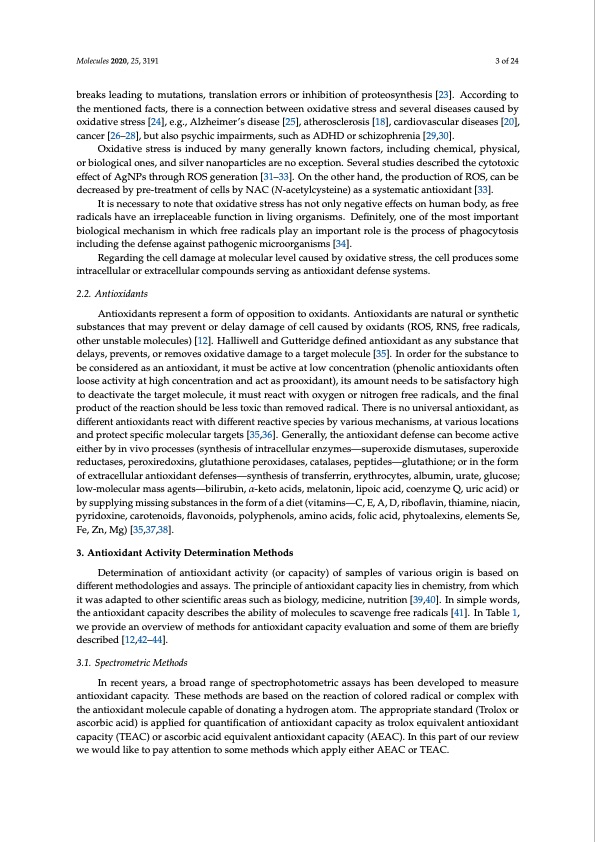
PDF Publication Title:
Text from PDF Page: 003
Molecules 2020, 25, 3191 3 of 24 breaks leading to mutations, translation errors or inhibition of proteosynthesis [23]. According to the mentioned facts, there is a connection between oxidative stress and several diseases caused by oxidative stress [24], e.g., Alzheimer’s disease [25], atherosclerosis [18], cardiovascular diseases [20], cancer [26–28], but also psychic impairments, such as ADHD or schizophrenia [29,30]. Oxidative stress is induced by many generally known factors, including chemical, physical, or biological ones, and silver nanoparticles are no exception. Several studies described the cytotoxic effect of AgNPs through ROS generation [31–33]. On the other hand, the production of ROS, can be decreased by pre-treatment of cells by NAC (N-acetylcysteine) as a systematic antioxidant [33]. It is necessary to note that oxidative stress has not only negative effects on human body, as free radicals have an irreplaceable function in living organisms. Definitely, one of the most important biological mechanism in which free radicals play an important role is the process of phagocytosis including the defense against pathogenic microorganisms [34]. Regarding the cell damage at molecular level caused by oxidative stress, the cell produces some intracellular or extracellular compounds serving as antioxidant defense systems. 2.2. Antioxidants Antioxidants represent a form of opposition to oxidants. Antioxidants are natural or synthetic substances that may prevent or delay damage of cell caused by oxidants (ROS, RNS, free radicals, other unstable molecules) [12]. Halliwell and Gutteridge defined antioxidant as any substance that delays, prevents, or removes oxidative damage to a target molecule [35]. In order for the substance to be considered as an antioxidant, it must be active at low concentration (phenolic antioxidants often loose activity at high concentration and act as prooxidant), its amount needs to be satisfactory high to deactivate the target molecule, it must react with oxygen or nitrogen free radicals, and the final product of the reaction should be less toxic than removed radical. There is no universal antioxidant, as different antioxidants react with different reactive species by various mechanisms, at various locations and protect specific molecular targets [35,36]. Generally, the antioxidant defense can become active either by in vivo processes (synthesis of intracellular enzymes—superoxide dismutases, superoxide reductases, peroxiredoxins, glutathione peroxidases, catalases, peptides—glutathione; or in the form of extracellular antioxidant defenses—synthesis of transferrin, erythrocytes, albumin, urate, glucose; low-molecular mass agents—bilirubin, α-keto acids, melatonin, lipoic acid, coenzyme Q, uric acid) or by supplying missing substances in the form of a diet (vitamins—C, E, A, D, riboflavin, thiamine, niacin, pyridoxine, carotenoids, flavonoids, polyphenols, amino acids, folic acid, phytoalexins, elements Se, Fe, Zn, Mg) [35,37,38]. 3. Antioxidant Activity Determination Methods Determination of antioxidant activity (or capacity) of samples of various origin is based on different methodologies and assays. The principle of antioxidant capacity lies in chemistry, from which it was adapted to other scientific areas such as biology, medicine, nutrition [39,40]. In simple words, the antioxidant capacity describes the ability of molecules to scavenge free radicals [41]. In Table 1, we provide an overview of methods for antioxidant capacity evaluation and some of them are briefly described [12,42–44]. 3.1. Spectrometric Methods In recent years, a broad range of spectrophotometric assays has been developed to measure antioxidant capacity. These methods are based on the reaction of colored radical or complex with the antioxidant molecule capable of donating a hydrogen atom. The appropriate standard (Trolox or ascorbic acid) is applied for quantification of antioxidant capacity as trolox equivalent antioxidant capacity (TEAC) or ascorbic acid equivalent antioxidant capacity (AEAC). In this part of our review we would like to pay attention to some methods which apply either AEAC or TEAC.PDF Image | Antioxidant Activity Determination of Silver Nanoparticles

PDF Search Title:
Antioxidant Activity Determination of Silver NanoparticlesOriginal File Name Searched:
molecules-25-03191.pdfDIY PDF Search: Google It | Yahoo | Bing
Turbine and System Plans CAD CAM: Special for this month, any plans are $10,000 for complete Cad/Cam blueprints. License is for one build. Try before you buy a production license. More Info
Waste Heat Power Technology: Organic Rankine Cycle uses waste heat to make electricity, shaft horsepower and cooling. More Info
All Turbine and System Products: Infinity Turbine ORD systems, turbine generator sets, build plans and more to use your waste heat from 30C to 100C. More Info
CO2 Phase Change Demonstrator: CO2 goes supercritical at 30 C. This is a experimental platform which you can use to demonstrate phase change with low heat. Includes integration area for small CO2 turbine, static generator, and more. This can also be used for a GTL Gas to Liquids experimental platform. More Info
Introducing the Infinity Turbine Products Infinity Turbine develops and builds systems for making power from waste heat. It also is working on innovative strategies for storing, making, and deploying energy. More Info
Need Strategy? Use our Consulting and analyst services Infinity Turbine LLC is pleased to announce its consulting and analyst services. We have worked in the renewable energy industry as a researcher, developing sales and markets, along with may inventions and innovations. More Info
Made in USA with Global Energy Millennial Web Engine These pages were made with the Global Energy Web PDF Engine using Filemaker (Claris) software.
Infinity Turbine Developing Spinning Disc Reactor SDR or Spinning Disc Reactors reduce processing time for liquid production of Silver Nanoparticles.
| CONTACT TEL: 608-238-6001 Email: greg@infinityturbine.com | RSS | AMP |